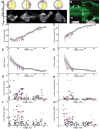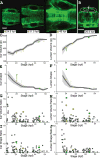Recovery of shape and size in a developing organ pair
- PMID: 28295855
- PMCID: PMC5426968
- DOI: 10.1002/dvdy.24498
Recovery of shape and size in a developing organ pair
Abstract
Background: Paired organs in animals are largely bilaterally symmetric despite inherent noise in most biological processes. How is precise organ shape and size achieved during development despite this noise? Examining paired organ development is a challenge because it requires repeated quantification of two structures in parallel within living embryos. Here we combine bilateral quantification of morphology through time with asymmetric perturbations to study regulation of organ shape, size, and symmetry in developing organ pairs.
Results: We present quantitative live imaging tools to measure the shape and size of the developing inner ears on both the left and right side simultaneously over time. By quantifying variation between the left and right inner ear (intrinsic noise) and between different individuals (extrinsic noise), we find that initial variability decreases over time in normal development to achieve symmetry. Early asymmetry is increased by environmental stress, but symmetry is still recovered over subsequent developmental time. Using multiple unilateral perturbations including Fgf signaling and ultraviolet light, we find that growth can be adjusted to compensate for a range of initial size and shape differences.
Conclusions: We propose that symmetry in developmental systems does not emerge through precise deterministic bilateral development, but rather through feedback mechanisms that adjust morphogenesis rates to account for variation. Developmental Dynamics 246:451-465, 2016. © 2017 Wiley Periodicals, Inc.
Keywords: inner ear; otic vesicle; regeneration; regulation; size control; symmetry.
© 2017 Wiley Periodicals, Inc.
Figures









Similar articles
-
Size control of the inner ear via hydraulic feedback.Elife. 2019 Oct 1;8:e39596. doi: 10.7554/eLife.39596. Elife. 2019. PMID: 31571582 Free PMC article.
-
Development of the zebrafish inner ear.Dev Dyn. 2002 Apr;223(4):427-58. doi: 10.1002/dvdy.10073. Dev Dyn. 2002. PMID: 11921334 Review.
-
Fgf8 and Fgf3 are required for zebrafish ear placode induction, maintenance and inner ear patterning.Mech Dev. 2002 Nov;119(1):91-108. doi: 10.1016/s0925-4773(02)00343-x. Mech Dev. 2002. PMID: 12385757
-
Emergence of a left-right symmetric body plan in vertebrate embryos.Curr Top Dev Biol. 2024;159:310-342. doi: 10.1016/bs.ctdb.2024.01.003. Epub 2024 Feb 5. Curr Top Dev Biol. 2024. PMID: 38729680 Review.
-
Cadherin-2 participates in the morphogenesis of the zebrafish inner ear.J Cell Sci. 2006 Dec 15;119(Pt 24):5169-77. doi: 10.1242/jcs.03299. J Cell Sci. 2006. PMID: 17158919
Cited by
-
An emerging role for tissue plasticity in developmental precision.Biochem Soc Trans. 2024 Jun 26;52(3):987-995. doi: 10.1042/BST20230173. Biochem Soc Trans. 2024. PMID: 38716859 Free PMC article. Review.
-
Size control of the inner ear via hydraulic feedback.Elife. 2019 Oct 1;8:e39596. doi: 10.7554/eLife.39596. Elife. 2019. PMID: 31571582 Free PMC article.
-
A Dilp8-dependent time window ensures tissue size adjustment in Drosophila.Nat Commun. 2022 Sep 26;13(1):5629. doi: 10.1038/s41467-022-33387-6. Nat Commun. 2022. PMID: 36163439 Free PMC article.
-
Intraspecific variability of the saccular and utricular otoliths of the hatchetfish Argyropelecus hemigymnus (Cocco, 1829) from the Strait of Messina (Central Mediterranean Sea).PLoS One. 2023 Feb 14;18(2):e0281621. doi: 10.1371/journal.pone.0281621. eCollection 2023. PLoS One. 2023. PMID: 36787328 Free PMC article.
-
Left-right symmetry of zebrafish embryos requires somite surface tension.Nature. 2022 May;605(7910):516-521. doi: 10.1038/s41586-022-04646-9. Epub 2022 Apr 27. Nature. 2022. PMID: 35477753
References
-
- Bryant PJ, Simpson P. Intrinsic and extrinsic control of growth in developing organs. The Quarterly Review of Biology. 1984;59:387–415. - PubMed
-
- Freeman DC, Brown ML, Dobson M, Jordan Y, Kizy A, Micallef C, Hancock LC, Graham JH, Emlen JM. Developmental instability: measures of resistance and resilience using pumpkin (Cucurbita pepo L.) Biological Journal of the Linnean Society. 2003;78:27–41.
-
- Freeman DC, Brown ML, Duda JJ, Graham JH, Emlen JM, Krzysik AJ, Balbach H, Kovavic DA, Zak JC. Leaf fluctuating asymmetry, soil disturbance and plant stress: a multiple year comparison using two herbs, Ipomoea pandurata and Cnidoscolus stimulosus. Ecological Indicators. 2005;5:85–95.
MeSH terms
Grants and funding
LinkOut - more resources
Full Text Sources
Other Literature Sources
Molecular Biology Databases

